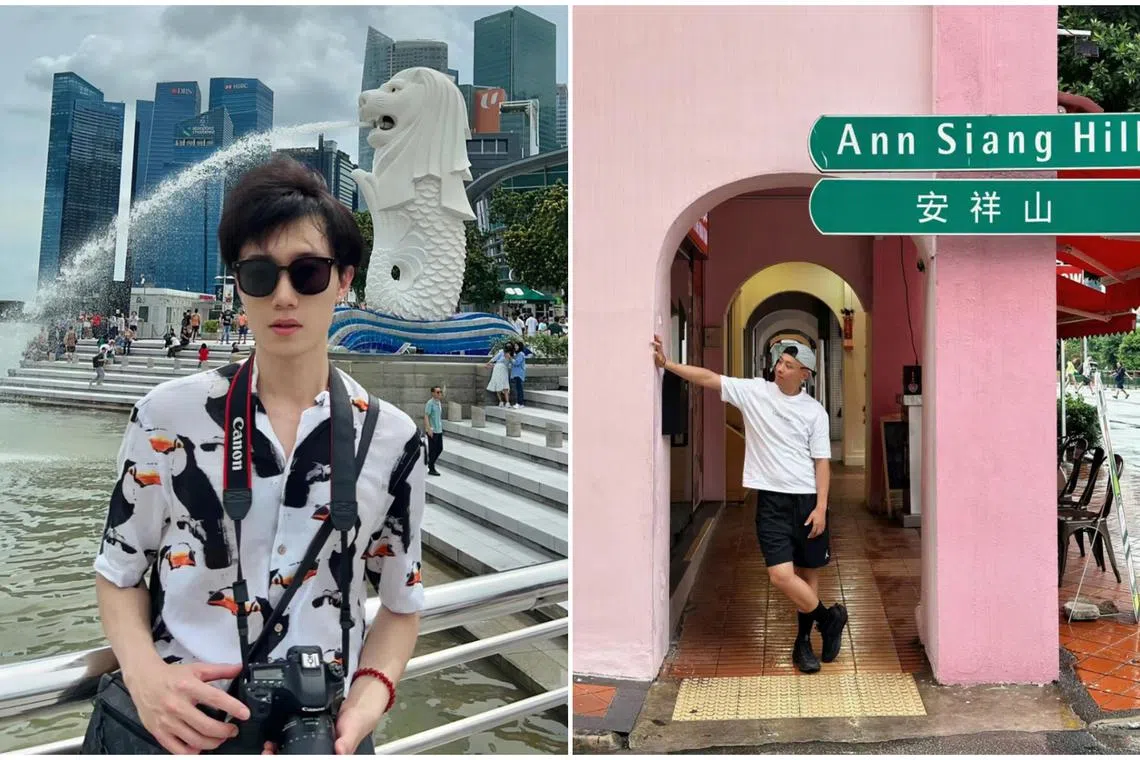‘Visitors can become poor’: Chinese netizens debate whether Singapore is too costly to visit
Sign up now: Get insights on Asia's fast-moving developments

Mr Albert Shi (left) took public transport in Singapore, while Mr Johnnie Zhu busted his budget by 30 per cent due to higher costs.
PHOTOS: ALBERT SHI, JOHNNIE ZHU
Follow topic:
BEIJING - When marketing planner Johnnie Zhu, 28, visited Singapore for a day over the New Year weekend, he blew his budget by 30 per cent on the back of higher-than-expected food and transport costs.
Mr Zhu, who was in transit on his way to Mount Bromo in Indonesia’s East Java, spent about 1,500 yuan (S$280) in that one day in Singapore. In Indonesia, he spent 500 to 600 yuan a day.
“I found the souvenirs at the airport particularly expensive,” he told The Straits Times.
Mr Zhu bought three small Merlion soft toys – each the size of about half a palm – for around 100 yuan and a keychain for 50 yuan for family and friends back home.
He lowered his costs by booking a cheaper room at the same hotel in Little India he had stayed at in 2019, on his first trip to Singapore.
“The price difference was about 300 yuan more for the same room, so I booked a cheaper option this time,” said Mr Zhu, who lives in Chengdu, the capital of Sichuan province in south-western China.
The high cost of visiting Singapore has become a hot topic of discussion in Chinese media after a visa waiver scheme kicked in on Feb 9.
The hashtag “visa-free travel to Singapore could result in visitors becoming poor if not careful” became the most searched-for topic on microblogging platform Weibo, two days after the new visa regime was announced on Jan 25.
The hashtag had 310 million views and sparked more than 9,000 discussion threads.
Some even discussed whether Singapore’s fines, such as a $500 fine for eating on MRT trains or a $1,000 fine for smoking in prohibited places, spitting or littering in public, made the Lion City prohibitively expensive.
“Travelling to Singapore is now ‘mianqian’ (visa-free) but not ‘mianfei’ (cost-free). The city is known as the capital of fines. Why would I go there? Travelling should be carefree, and not being constantly worried about what not to do,” read a post on Jan 27 by netizen YanyiElaine from Anhui province in central China, who has 11,100 followers on Weibo.
The Chinese media, especially the tabloids, have also highlighted the high cost of living in Singapore.
On Feb 18, Phoenix Weekly, a magazine focusing on social news based in Shenzhen in southern China, ran a story with the headline “The first batch of middle-class Chinese who visited Singapore visa-free has already gone bankrupt”.
The article claimed that, in Singapore, a can of soft drink can cost $2, a glass of fruit juice about $8, and chicken claws, a cheap snack in China that costs about 25 yuan in Beijing, are 130 yuan for a large plate, though the article did not state where.
In response to such concerns, some Chinese nationals based in Singapore offered tips on how to cut costs. On Xiaohongshu, a popular Instagram-like app in China, they advise people to save money by eating at hawker centres and shopping at suburban malls such as Changi City Point, which is known for its outlet stores.
Mr Albert Shi, 25, who works for an Internet company in Beijing, said taking public transport helped him and his parents stay within budget for their Singapore visit in December 2023. The seven-day stay was Mr Shi’s third trip to Singapore.
“It’s true that Singapore is too expensive, but it is also understandable given that it relies on imports. It is also normal for consumption to be expensive in a developed country. Accommodation, transport and some food and beverage sectors are more costly than China’s, but there are also hawker centres, so visitors have a choice,” he added.
Mr Andrew Phua, the Singapore Tourism Board’s executive director for Greater China, told ST that the agency has always emphasised Singapore’s diverse offerings, from accommodation to transport.
“This includes affordable hawker fare to reinforce our reputation as a haven for foodies,” he added.
Mr Phua acknowledged that the Republic is often called a “fine city” due to its regulations but added that these “are essential in ensuring that Singapore continues to be a safe and orderly place for both locals and travellers”.
“The safe and trusted attributes of Singapore have made it a compelling destination, in addition to its family-friendly and bilingual environment, and a diverse range of quality tourism offerings.”
Despite the complaints about cost and fines, there was a sharp increase in Chinese visitors to Singapore during the recent Chinese New Year holidays on the back of the visa-free arrangement and more Chinese travelling out of the country.
Data from Tongcheng, one of China’s leading travel platforms, showed that, from Feb 9 to 17 – China’s official Spring Festival holiday – hotel bookings in Singapore increased by more than seven times, compared with the festive period in 2023.
Air ticket bookings from mainland China to Singapore increased by more than five times in the same period.
Some Chinese netizens have also praised Singapore’s regime of implementing fines against what they consider to be poor behaviour, and asked whether the same can be done in China.
The Chinese were Singapore’s top source of tourists and tourist dollars before the pandemic. But even though China fully reopened its borders in late 2022, they have been more cautious in their spending and travel plans following three years of the country’s restrictive zero-Covid policy.
In addition, the strengthening Singapore dollar makes travel more costly. One Singapore dollar now exchanges for 5.35 yuan, compared with 5.02 yuan in April 2020.
Dr Liu Simin, vice-president of the tourism branch of the China Society for Futures Studies research institute in Beijing, told ST that the pandemic increased the costs of international travel and worsened inflation in developed economies like Singapore.
“China’s strict three-year epidemic prevention and control has also caused damage to its economy, affecting the income of the Chinese and their consumption habits,” he added.
Having a visa-free arrangement will make more Chinese tourists consider Singapore, including those travelling out of the country for the first time, Dr Liu said.
Overall, it is likely that countries such as Malaysia, Thailand and Indonesia, which give more bang for the buck, will remain popular with Chinese tourists, he added. Visas are not needed for those countries.
OCBC Bank’s head of Greater China research Tommy Xie said that Chinese tourists have experienced “a significant increase in costs due to the depreciation of the renminbi against the Singapore dollar and inflation, especially since the Covid-19 pandemic”.
But “it’s important to note that a weaker currency does not necessarily deter short-term visitors from travelling overseas”, he added.
“Ultimately, the exchange rate is only a small factor in people’s decision to travel.”
Moreover, it is not just Chinese tourists who may think twice about making plans to visit Singapore.
He noted that other regional tourists, such as Malaysians and Indonesians, are likely to find the island state more expensive due to current exchange rates.
“Unfortunately, this situation is unlikely to be resolved in the near term,” he added.


